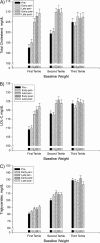Lipid changes during the menopause transition in relation to age and weight: the Study of Women's Health Across the Nation
- PMID: 19357323
- PMCID: PMC2727246
- DOI: 10.1093/aje/kwp043
Lipid changes during the menopause transition in relation to age and weight: the Study of Women's Health Across the Nation
Abstract
Few studies have prospectively examined lipid changes across the menopause transition or in relation to menopausal changes in endogenous hormones. The relative independent contributions of menopause and age to lipid changes are unclear. Lipid changes were examined in relation to changes in menopausal status and in levels of estradiol and follicle-stimulating hormone in 2,659 women followed in the Study of Women's Health Across the Nation (1995-2004). Baseline age was 42-52 years, and all were initially pre- or perimenopausal. Women were followed annually for up to 7 years (average, 3.9 years). Lipid changes occurred primarily during the later phases of menopause, with menopause-related changes similar in magnitude to changes attributable to aging. Total cholesterol, low density lipoprotein cholesterol, triglycerides, and lipoprotein(a) peaked during late peri- and early postmenopause, while changes in the early stages of menopause were minimal. The relative odds of low density lipoprotein cholesterol (> or =130 mg/dL) for early postmenopausal, compared with premenopausal, women were 2.1 (95% confidence interval: 1.5, 2.9). High density lipoprotein cholesterol also peaked in late peri- and early postmenopause. Results for estradiol and follicle-stimulating hormone confirmed the results based on status defined by bleeding patterns. Increases in lipids were smallest in women who were heaviest at baseline.
Figures



References
-
- Kannel W, Hjortland MC, McNamara PM, et al. Menopause and risk of cardiovascular disease: the Framingham Study. Ann Intern Med. 1976;85(4):447–452. - PubMed
-
- Davis C, Pajak A, Rywik S, et al. Natural menopause and cardiovascular disease risk factors: the Poland and US Collaborative Study on Cardiovascular Disease Epidemiology. Ann Epidemiol. 1994;4(6):445–448. - PubMed
-
- Lindquist O, Bengtsson C, Lapidus L. Relationships between the menopause and risk factors for ischaemic heart disease. Acta Obstet Gynecol Scand Suppl. 1985;130:43–47. - PubMed
-
- Jensen J, Nilas L, Christiansen C. Influence of menopause on serum lipids and lipoproteins. Maturitas. 1990;12(4):321–331. - PubMed
-
- Akahoshi M, Soda M, Nakashima E, et al. Effects of menopause on trends of serum cholesterol, blood pressure, and body mass index. Circulation. 1996;94(1):61–66. - PubMed
Publication types
MeSH terms
Substances
Grants and funding
- AG012553/AG/NIA NIH HHS/United States
- AG012554/AG/NIA NIH HHS/United States
- AG012539/AG/NIA NIH HHS/United States
- AG012531/AG/NIA NIH HHS/United States
- U01 AG012495/AG/NIA NIH HHS/United States
- U01 AG012505/AG/NIA NIH HHS/United States
- AG012535/AG/NIA NIH HHS/United States
- AG012546/AG/NIA NIH HHS/United States
- NR004061/NR/NINR NIH HHS/United States
- U01 AG012554/AG/NIA NIH HHS/United States
- U01 AG012535/AG/NIA NIH HHS/United States
- U01 AG012553/AG/NIA NIH HHS/United States
- U01 NR004061/NR/NINR NIH HHS/United States
- U01 AG012539/AG/NIA NIH HHS/United States
- AG012495/AG/NIA NIH HHS/United States
- U01 AG012546/AG/NIA NIH HHS/United States
- U01 AG012531/AG/NIA NIH HHS/United States
- AG012505/AG/NIA NIH HHS/United States
LinkOut - more resources
Full Text Sources
Other Literature Sources
Medical
Molecular Biology Databases

